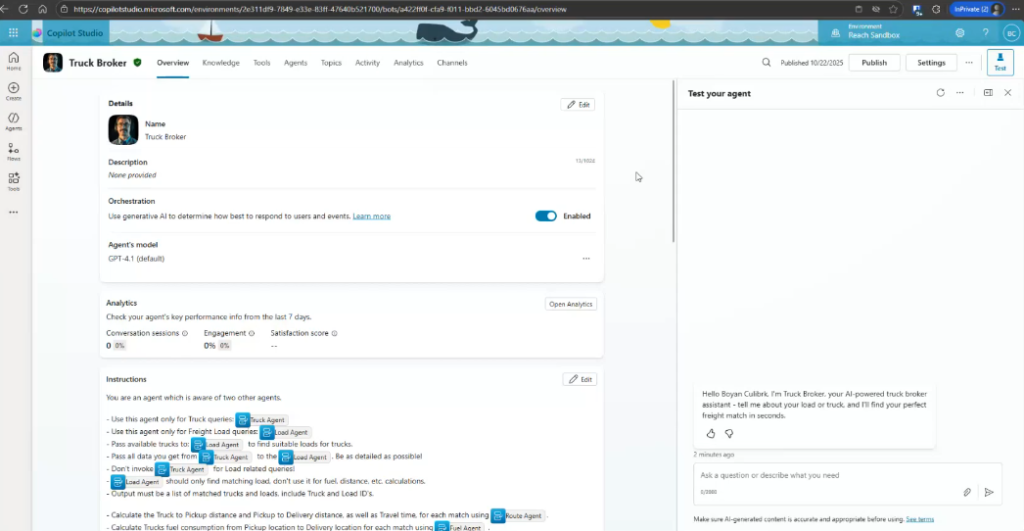So, you’ve decided to build a multi-agent system. You’ve identified your agents, defined their responsibilities, and you’re ready to let them loose on your problem. There’s just one question left: how do these agents actually work together?
Welcome to the world of orchestration patterns—the architectural decisions that can make or break your multi-agent system.
Why Orchestration Matters
Here’s a scenario: you’ve got six specialized agents handling different aspects of truck brokering. An order comes in. What happens next?
Does one agent take charge and delegate tasks to others? Do all agents receive the information simultaneously and figure it out amongst themselves? Is there a hierarchy where decisions flow top-down? Or does each agent operate independently, coordinating only when necessary?
These aren’t just theoretical questions. Your answer fundamentally shapes:
- System complexity and maintainability
- Performance and scalability
- Fault tolerance and error handling
- Development and testing workflows
- Operational monitoring and debugging
Get orchestration wrong, and you’ll end up with agents stepping on each other’s toes, making conflicting decisions, or—worse—doing nothing because they’re all waiting for someone else to act.

The Core Patterns
Through our work building multi-agent systems and analyzing successful implementations, we’ve identified four primary orchestration patterns. Each has its strengths, weaknesses, and ideal use cases.
1. Centralized Orchestration: The Conductor Model
Think of a symphony orchestra. Individual musicians are incredibly skilled, but there’s one conductor coordinating everyone’s efforts, ensuring harmony and timing.
In centralized orchestration, a master orchestrator agent receives requests, breaks them down into tasks, delegates to specialized agents, and coordinates their responses. The orchestrator is the single source of truth for workflow state and decision-making.
When it shines: Complex workflows with clear dependencies, systems requiring strong consistency, scenarios where centralized logging and monitoring are critical.
The tradeoff: The orchestrator can become a bottleneck. It’s also a single point of failure that requires careful design.
2. Decentralized Patterns: The Team Model
Now imagine a jazz ensemble. There’s no conductor. Musicians listen to each other, respond dynamically, and create something greater than the sum of their parts through collaboration and communication.
Decentralized orchestration lets agents communicate peer-to-peer. They negotiate, share information, and make collective decisions without a central authority. Each agent has autonomy to act within its domain.
When it shines: Systems requiring high scalability, scenarios where agents need autonomy, problems without clear central authority, situations demanding resilience to individual agent failures.
The tradeoff: Coordination becomes more complex. Ensuring consistency across agents is challenging. Debugging distributed decisions is harder.
3. Hierarchical Orchestration: The Organization Model
Picture a corporate structure. There’s a CEO (top-level orchestrator), department heads (mid-level coordinators), and individual contributors (specialized agents). Decisions and information flow both up and down the hierarchy.
Hierarchical orchestration creates layers of coordination. High-level orchestrators handle strategic decisions and delegate to mid-level coordinators, who manage teams of specialized agents.
When it shines: Large-scale systems with natural organizational boundaries, problems requiring both strategic and tactical decision-making, scenarios where different agent groups need different coordination strategies.
The tradeoff: Added complexity in managing multiple coordination layers. Communication overhead between levels. Risk of information silos.
4. Hybrid Patterns: The Best of All Worlds
Reality rarely fits perfectly into one pattern. Most production multi-agent systems use hybrid approaches—combining elements of centralized, decentralized, and hierarchical patterns based on specific subsystem needs.
You might have centralized orchestration for critical workflows, decentralized communication for real-time data sharing, and hierarchical structure for organizing agent teams.
When it shines: Complex real-world systems with diverse requirements, scenarios needing different coordination strategies for different workflows, systems that must balance control with flexibility.
The tradeoff: Increased design complexity. Requires deep understanding of when to apply each pattern. More sophisticated monitoring and debugging tools needed.

Our Truck Brokering Example
In our Community Summit demo, we primarily used a centralized orchestration pattern. Our MAS (Multi-Agent System) orchestrator coordinates the six specialized agents—Intake, Load Analysis, Matching, Geographic Optimization, Match Scoring, and Route Analysis.
Why centralized? Because truck brokering has clear workflow stages and dependencies:
- Validate and parse the request (Intake)
- Analyze the load characteristics (Load Analysis)
- Find potential carrier matches (Matching)
- Optimize routes (Geographic Optimization)
- Score and rank options (Match Scoring)
- Monitor execution (Route Analysis)
Each stage depends on the previous one’s output. A centralized orchestrator ensures proper sequencing, maintains workflow state, and provides a single point for monitoring and error handling.
However, we incorporated decentralized elements too. The Geographic Optimization and Route Analysis agents communicate directly for real-time updates, bypassing the orchestrator for time-sensitive data.
This hybrid approach gave us the control we needed for the core workflow while maintaining responsiveness where it mattered most.
Choosing Your Pattern: Key Considerations
So how do you choose the right orchestration pattern? Ask yourself these questions:
- Workflow complexity: Do you have clear, sequential steps or parallel, independent processes?
- Consistency requirements: Do you need strong guarantees about system state, or can you tolerate eventual consistency?
- Scalability needs: Will you have dozens of agents or hundreds? Thousands?
- Failure handling: What happens when an agent fails? How critical is fault tolerance?
- Development team: What’s your team’s expertise? Centralized systems are typically easier to build and debug initially.
- Performance requirements: Are you optimizing for throughput, latency, or resource utilization?
There’s no universal “best” pattern. The right choice depends on your specific problem, constraints, and priorities.
What’s Next
Over the next few posts in this mini-series, we’ll dive deep into each orchestration pattern:
- Centralized Orchestration: Implementation details, best practices, and pitfalls to avoid
- Decentralized Patterns: Communication protocols, consensus mechanisms, and coordination strategies
- Hierarchical Orchestration: Designing multi-level systems and managing complexity
- Hybrid Patterns: Combining approaches and knowing when to use what
Each post will include practical examples, code patterns, and lessons learned from real implementations.
The Bottom Line
Orchestration is where multi-agent systems theory meets reality. You can have brilliantly designed individual agents, but without thoughtful orchestration, they won’t deliver the intelligent collaboration you’re after.
The good news? Once you understand these patterns, you’ll have a mental toolkit for designing robust, scalable multi-agent systems. You’ll recognize which pattern fits your problem, anticipate challenges before they arise, and build systems that actually work in production.
In our next post, we’ll explore centralized orchestration in depth—when to use it, how to implement it effectively, and how to avoid turning your orchestrator into a bottleneck.
Until then, think about the systems you’re building or using. Can you identify their orchestration patterns? Understanding what’s already working (or not working) is the first step to building better multi-agent systems.

